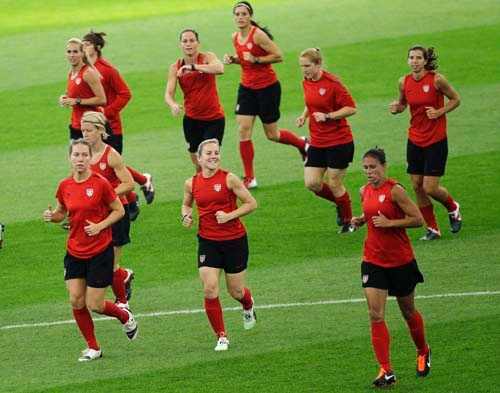Legacy of 1999 World Cup winners can’t be topped
It is a legacy that can't be caught, a shadow that can't be escaped, a popularity that can't be duplicated.
A team that can't be matched.
The United States might win another World Cup in women's soccer today, might beat Japan and hoist the gold trophy for the first time in 12 years, but the Americans shouldn't now or ever be compared to the side that won in 1999, to the players who changed the perception of women's sports like none before or since.
The current U.S. team is many things. Fun to watch. Patriotic. Grinders. Big. Strong. Athletic.
It never gives up.
It's the sort of stuff that defines America.
But it is not a side equivalent to 1999, not close in tactical skill or long-term influence. Of the 11 best players at the World Cup back then, the U.S. had eight or nine. Of the 11 best in Germany the past three weeks, the U.S. had two or three.
The Americans made for the best team in '99.
In terms of skill, there are six or seven better ones this time.
There's nothing wrong with that. There always will be just one Dream Team in basketball. The first one. The one in 1992 with Michael, Magic and Larry. But it hasn't stopped the U.S. from winning three of the four Olympic gold medals in the sport since.
The same goes for this World Cup. No one has proven better than the U.S. at discovering ways to advance. Germany, though, has more skilled players. So does Brazil and France and Sweden and Japan. Maybe even Australia. Maybe even England.
The U.S. has been outplayed at the midfield in its past three games. Its soccer lacks an artistic, sophisticated edge, of which other nations have gained mightily on the Americans over 12 years.
In a 1999 friendly leading up to the World Cup, the U.S. beat Japan 9-0 and outshot its opponent 35-0. Things have since changed on both sides.
What hasn't for the U.S.: It again owns an incredible will to win.
At day's end, it's only about which side proves to be the last one standing, and the U.S. is one victory from that moment because of things such as fitness and desire.
It makes for a nice lasting image of a likable team.
The lasting image of '99 is Brandi Chastain tearing off her jersey after scoring the winning penalty kick against China, beginning a sports-bra-unmasking celebration that sent American women's soccer to a place of nationalistic pride it had never before enjoyed. The exposure, beginning with Chastain's ripped midsection, was unprecedented.
Little girls from one coast to the next watched and cheered and dreamed of being the next Mia Hamm. The media went into a women's soccer frenzy and a springboard of interest was created, along with a professional league in the States that featured those '99 heroes.
A league that folded before the 2003 World Cup.
That's how fast it took for momentum to cease, for millions of eyes to again glance away from women's soccer.
Yes. Even that special a team owned a window of appeal.
Understand that the Women's World Cup falls at a time on the sports calendar best described as dead, when there is no NFL or NBA or high school or college sports to speak of, when Major League Baseball is more about home run derbies than pennant races. Even so, TV ratings in the States have been weak for this World Cup. It's not surprising.
There is an East Coast-based league called Women's Professional Soccer today, and it's not doing well and many think it could be gone in a year. Maybe a win by the United States today could draw a template for some future success. Maybe the faces of Abby Wambach and Hope Solo will grace the front of a cereal box in the next few weeks.
But it's not going to be like 1999, because nothing has been as thrilling for the sport or come close to matching the importance of that team. It was special for as long as people cared.
What you have today is an American side of players who earn a lot (on average $300,000 annually) to play soccer full time, whose federation has the most power and money, whose fitness level has paid off in this World Cup against nations with far less wealth and advantages, whose best tactical move is to bang balls into the middle for a player (Wambach) who at 5 feet 11 inches and 175 pounds overpowers smaller opponents, who doesn't play beautiful soccer by any means but offers a never-say-die attitude that has captured U.S. sports fans who might not otherwise notice.
There's nothing wrong with that. It's a likable group. It has made for an entertaining three weeks.
It's just not 1999.
That shadow remains far too big to escape.
Las Vegas Review-Journal sports columnist Ed Graney can be reached at egraney@reviewjournal.com or 702-383-4618. He can be heard from 3 to 5 p.m. Monday and Thursday on "Monsters of the Midday," Fox Sports Radio 920 AM. Follow him on Twitter: @edgraney.






















